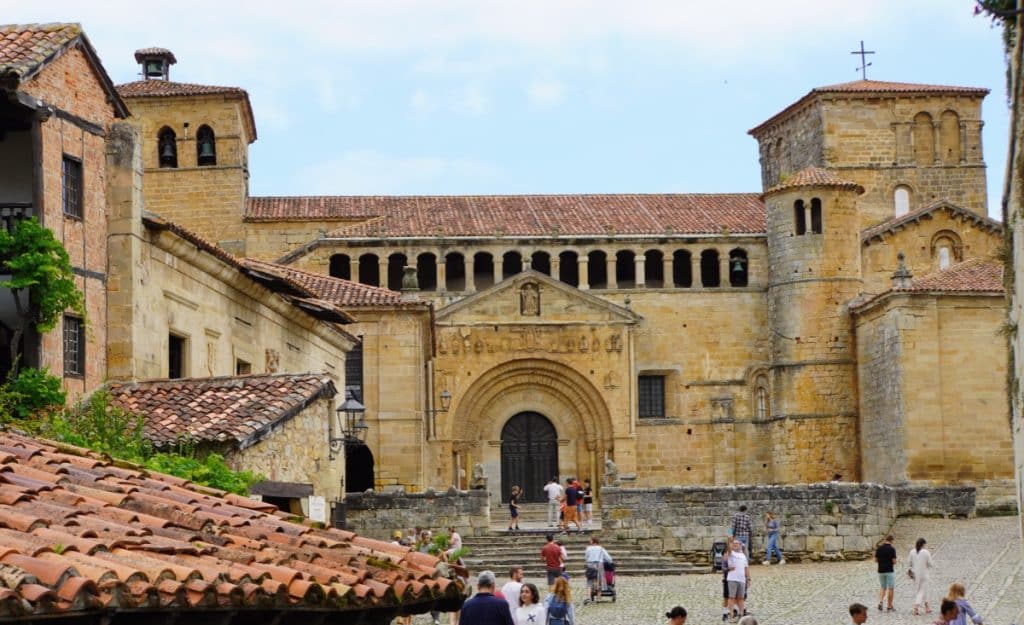Jean-Paul Sartre described Santillana del Mar as the most beautiful village in Spain. Its streets were walked by fictional characters such as Gil Blas and have a charm that Sartre himself praised in his novel “La Nausée”. And to be honest, I was also impressed by the streets.

A group of monks who settled in an uninhabited area near the village of Planes at the foot of Mount Vispieres in the 8th century took a relic of the martyr Juliana with them. They built a hermitage and displayed the relic. Today, this is considered the beginning of the history of Santillana del Mar.

A monastery was founded, around which numerous buildings were erected. Over time, a town developed with the religious centre “Sancta Luliana”, today’s Santillana. The abbey’s area of influence expanded due to numerous concessions and royal privileges. Pilgrims passed by on their way to Santiago de Compostela and the inhabitants of the town prospered economically. In 1220, Alfonso VIII granted Santillana city rights.
From this point onwards, the influence of the abbey began to wane. Finally, the town was handed over to the first Marquis of Santillana. The town’s heyday was now almost over. The nobility became increasingly impoverished and many inhabitants moved away. It was only when the former Spanish settlers returned from the West Indian colonies and brought “new” money to the city that the almost pompous villas with their family coats of arms, which still dominate the cityscape today, were built.

History from the 18th century onwards
In the 18th century, Santillana became known beyond the Spanish borders. The French writer Lesage wrote the work “Gil Blas de Santillana”, which tells the story of a fictional hero and the town. Lesage was never in the city or in Spain.
In the 1920s, Count Güell made a decisive contribution to making the city interesting again. He renovated the Barreda Palace and made it possible for theatre performances to be held there. Even King Alfonso XIII and his host, the Marquis of Benemejís, came to the performances, which naturally attracted additional audiences.

Anyone who comes to Santillana del Mar will recognise three big lies:
Santillana del Mar is not holy (santa).
Santillana del Mar is not flat (llana).
The town is not by the sea (mar).
Nevertheless, there is something about the town that is difficult to describe and that captivates tourists every year. You have to feel and experience Santillana.
Santillana del Mar: Collegiate church of Santa Juliana
The place that most tourists are sure to visit during their stay is the impressive church with the neighbouring monastery.
The history of the picturesque collegiate church of Santa Juliana dates back to the 12th century. Originally a modest monastery, it was built by monks whose aim was to bring new life to the region.

Back then, it was a simple stone construction with a rectangular apse and a wooden roof. Although nothing remains of the original monastery today, the imposing Romanesque church that stands in its place tells a fascinating story.
View inside the church
The first view of the church is breathtaking. The southern main façade, with its inviting atrium and magnificent round arch, casts a spell over me. The Pantocrator in the frieze and the image of Santa Juliana, lovingly carved into a niche, almost magically attract the eye.

I take a moment to admire the finely crafted capitals. They are decorated with a rich selection of floral and figurative motifs and illustrate the skill of the stonemasons.

I reach the cloister through a side entrance. Here I discover capitals depicting floral, geometric and biblical scenes. If you take a closer look at the scenes depicted, you can recognise scenes from the Old and New Testaments.

From the cloister, you enter the nave. The main altarpiece, a masterpiece of late Gothic and Plateresque styles, dates back to the Renaissance and was created at the end of the 15th and beginning of the 16th century.
The Lignum Crucis is of particular importance to the church and pilgrims. The relic was a gift from the Abbot of Santo Toribio to the parish. Its presence in the church was intended to stop pilgrims in the town on their way to Santiago de Compostela without having to make a diversion via Santo Toribio. The relic is housed in a Gothic silver cross from the 15th century.
Torre de Don Borja
It is quite remarkable what beautiful and well-preserved medieval buildings can be seen in Santillana del Mar.

I was particularly struck by the Torre de Don Borja, which dates back to the 15th century. The Gothic tower is named after Don Borja Barreda, the owner of the estate in 1844. The structure has since been renovated several times and today the tower is one of the most striking buildings and home to the Santillana Foundation.
Torre de Merino
The tower was the seat of the Merino, the king’s representative. It was located here from 1209, after Santillana was named the capital of the Asturias de Santillana.

Cake and milk at Casa Quevedo
My first thought when I was made aware of this little shop was “what’s so special about it?” At the latest after hearing the story behind it, I became curious…
There was a time when women had to be very resourceful to make ends meet for their families. Often the working men’s money was no longer enough and creativity was required.

In Santillana, Luisa “invented” the saying “if you don’t have a glass of milk and a quesada, you won’t get married”. In her Casa Quevedo, she offered quesada/cake and milk to match.
Still run as a family business, the farm still exists today. Cake and milk are sold in front of the church gates. Most people certainly don’t buy it because they want to get married, but because the story behind it is exciting today.

Of course I also bought a slice of cake, but without milk. A wonderfully sweet and fluffy sponge cake that I really enjoyed.
Lunch at the Parador de Santillana Gil Blas
The Parador de Santillana Gil Blas is located in a manor house from the 17th century. Inside the beautiful stone house is an elegant and cosy restaurant. Here you can eat well and in style.
The restaurant “El Jardín de Gil Blas” offers traditional Cantabrian cuisine. It emphasises regional products and serves hearty stews, excellent meat and fresh fish. Typical dishes include cocido montañés, a stew made from pulses and vegetables with local meat and alubias con chorizo (beans with chilli sausage).


During my visit, we ate an excellent multi-course meal and drank a very good regional wine to go with it. A wonderful end to a short stroll through the city.
The visit to Santillana del Mar was part of the programme on the Costa Verde Express.


Leave a Reply